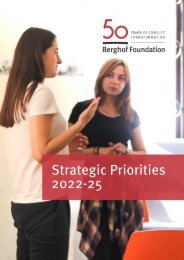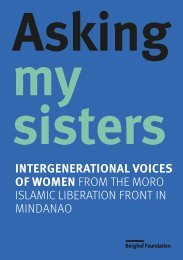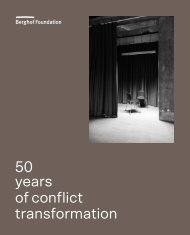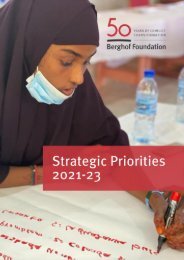Berghof Glossary on Conflict Transformation
The Berghof Glossary on Conflict Transformation presents 20 of the main principles and approaches used by the Berghof Foundation in its work. It is a concise and accessible exploration of what it takes to create “space for conflict transformation”. 2019 edition.
The Berghof Glossary on Conflict Transformation presents 20 of the main principles and approaches used by the Berghof Foundation in its work. It is a concise and accessible exploration of what it takes to create “space for conflict transformation”. 2019 edition.
Create successful ePaper yourself
Turn your PDF publications into a flip-book with our unique Google optimized e-Paper software.
Preventing Violence<br />
VIOLENCE PREVENTION | acknowledges the issues at stake in<br />
c<strong>on</strong>flict, yet implements short-term to l<strong>on</strong>g-term measures offering<br />
alternatives to direct, structural and cultural violence and limiting<br />
the use of force, often in places seen as particularly vulnerable.<br />
C<strong>on</strong>flict transformati<strong>on</strong> and peacebuilding strive to integrate<br />
a preventative mindset already in the early stages of c<strong>on</strong>flicts<br />
and highlight the important role of educating for n<strong>on</strong>-violence.<br />
merely <strong>on</strong> the perpetrator and the victim of violence but involve<br />
the whole envir<strong>on</strong>ment affecting them – the relevant causes and<br />
drivers, the systemic c<strong>on</strong>necti<strong>on</strong>s as well as the sometimes hidden<br />
implicati<strong>on</strong>s.<br />
Dimensi<strong>on</strong>s of violence preventi<strong>on</strong>: an array of approaches<br />
C<strong>on</strong>flict may be a necessary – even formative – part of human existence,<br />
but we can avoid c<strong>on</strong>flict turning into violence. With violence<br />
understood in a broad sense, the task of violence preventi<strong>on</strong><br />
necessarily becomes multi-faceted, involving many fields<br />
and actors. While preventi<strong>on</strong> should ideally be undertaken proactively<br />
and early <strong>on</strong>, attenti<strong>on</strong> often <strong>on</strong>ly focuses <strong>on</strong> a c<strong>on</strong>flict<br />
after violence has occurred. For example, peacebuilding efforts<br />
in post-war settings often prioritise preventi<strong>on</strong>, in order to counter<br />
or pre-empt a renewed outbreak of fighting, or to safeguard<br />
sensitive de-escalati<strong>on</strong> processes during transiti<strong>on</strong> phases. Typical<br />
tools and methods include early warning, c<strong>on</strong>fidence- and<br />
security-building measures, preventive diplomacy and peacekeeping,<br />
and peace educati<strong>on</strong>.<br />
The preventi<strong>on</strong> of violence is a key resp<strong>on</strong>sibility of any nati<strong>on</strong>-state,<br />
for it bears the exclusive right to the legitimate use<br />
of force within its borders. It is the resp<strong>on</strong>sibility of states and<br />
their authorities to provide all necessary legislati<strong>on</strong>, instituti<strong>on</strong>s<br />
and strategies to prevent violent attacks <strong>on</strong> any of their citizens.<br />
124










